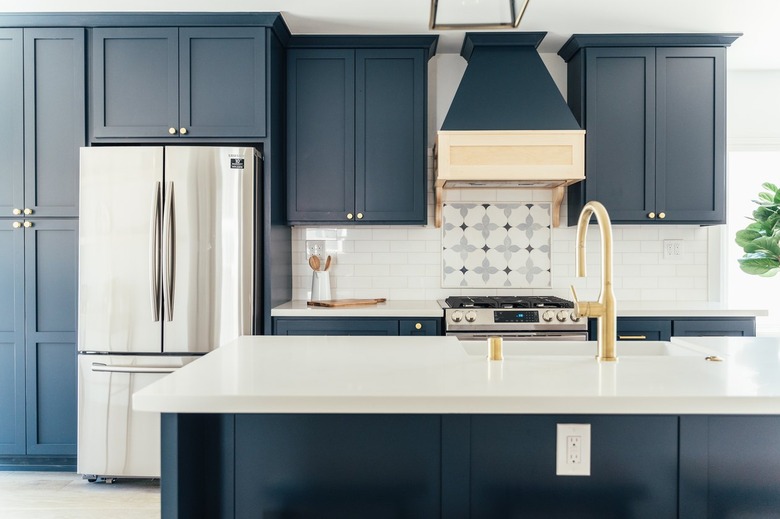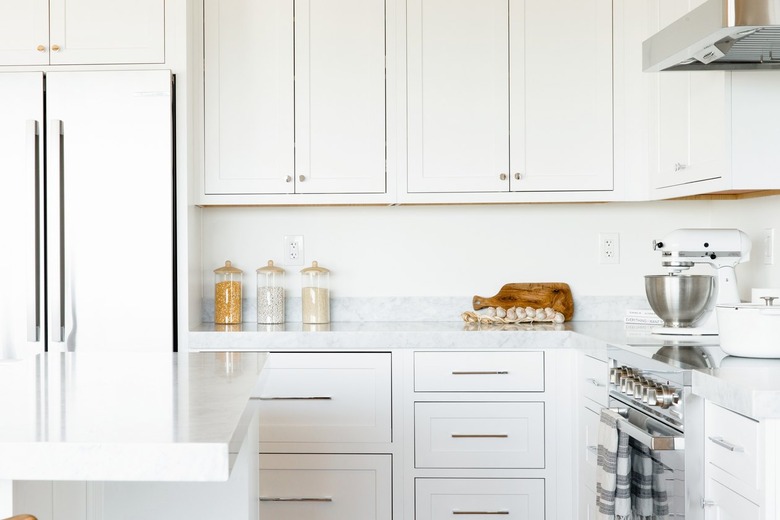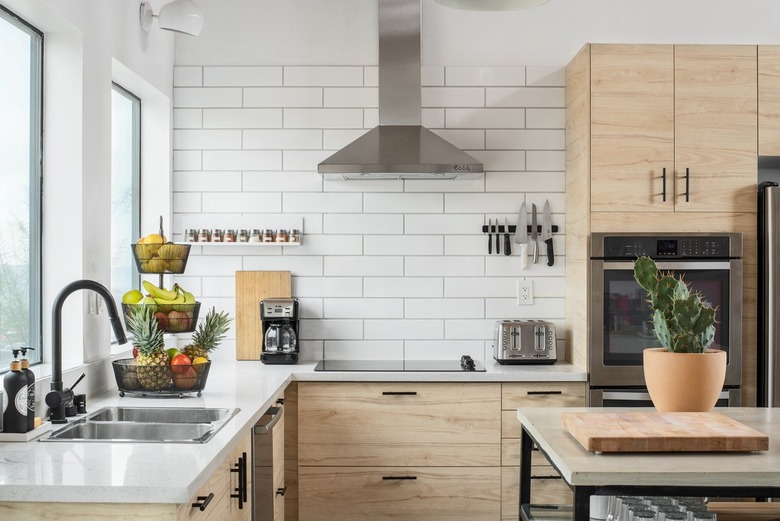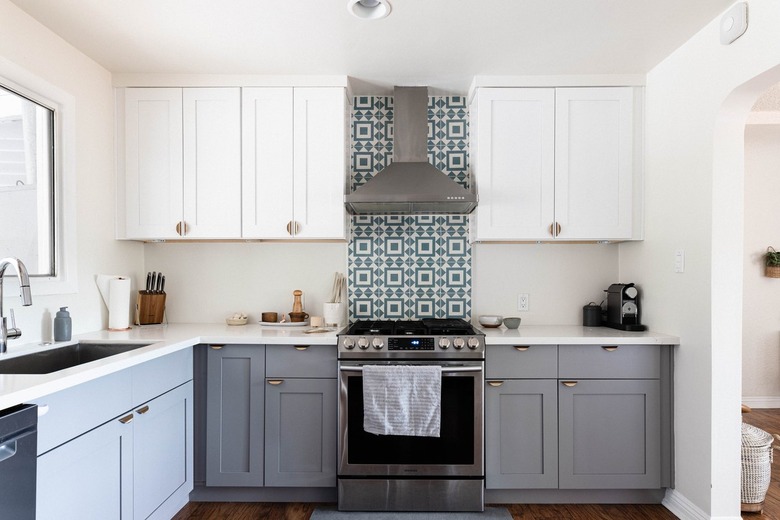Painted Vs. Stained Cabinets: Which One Works Best For Your Kitchen?
We may receive a commission on purchases made from links.
Stained and painted cabinets can both look fantastic in the kitchen, but deciding which works best for your new kitchen is a difficult choice. Your cabinets are likely to be the single largest expense of your kitchen remodel, and they cover a lot of wall space, so they really make an impact on the aesthetics. The choice really comes down to what look you want to achieve in the space — painted cabinets are quite popular due to the wide array of available colors, but quality stained cabinets are natural and warm.
Most painted cabinets that you purchase have a factory-applied finish that is sprayed on for flawless results. Stained cabinets have a clear protective finish (also typically factory-applied) that lets the natural grain and character of the wood show through.
Trying to decide between stained and painted cabinets? Here's a guide to help you consider the pros, cons, and the costs of each.
Tip
The choice between painted and stained cabinetry is largely about personal preference. Stained cabinets tend to last longer, but painted cabinets offer much more customization.
Painted Cabinets
Painted Cabinets
Painted cabinets are available in both hardwood and medium-density fiberboard (MDF) construction, both of which have pros and cons. Hardwood is quite durable and is often viewed as more desirable than MDF. It also has a natural grain that many people find quite attractive. This grain often shows through paint, however, which can be a con for those looking for a sleek, smooth finish.
Temperature matters when it comes to painted kitchen cabinets. If you want painted wooden cabinets, remember that wood expands and contracts with temperature changes. If your house is air conditioned and is kept at a comfortable temperature all year, this won't be a problem for you. However, if you live in an older home without A/C, the paint on your cabinets may start to crack as the wood expands and then contracts. In this case, you'll want to opt for MDF if you want painted cabinets.
MDF is a man-made substance crafted from wood fiber, resin, and wax. MDF is less prone to cracking and warping than natural hardwoods. It also lacks a wood grain, making it an excellent choice for painted cabinets. MDF also offers a bit more style flexibility. Because of the way it's made, you can often get away with drilling and cutting MDF in ways that hardwood won't allow.
Painted cabinets are super on-trend, likely because of the flexibility they offer. Paint comes in such a wide variety of colors that you can fully customize the look of your kitchen. They offer a smooth, clean finish that works well in modern kitchens, but they also come in colors and styles that can create a charming cottage kitchen feel.
Painted cabinets do have a few drawbacks. Unfortunately, painted cabinets are susceptible to visible chips and dings. If so, you may have to touch up your painted cabinets periodically. Color-matching the original paint can prove challenging, however. You may also find that even if you match the color well, your brushed-on touch-up may have a different texture than the original factory spray paint.
Stained Cabinets
Stained Cabinets
If you prefer the look of natural wood to paint, stained cabinets could prove the better option for you. These cabinets are often made from hardwoods, like oak, hickory, maple, and walnut. Although it is a softer wood, some homeowners choose pine wood for their cabinets because of its rustic feel and less expensive price tag.
Stained wood is available in fewer colors than painted wood but still offers a wide array of color choices in hues of browns, reds, and grays. Some woods, like rosewood, cherry, and mahogany, are so distinctively colored that cabinetmakers seal them without staining them at all, letting their natural beauty shine through. Either way, understand that wood stains tend to enhance what's already there, and staining a beautiful piece of hardwood can really turn up the charm. If you don't like the grain pattern or coloring of a particular wood when it's bare, however, you'll probably dislike it even more after it's stained and sealed.
Generally, stained cabinets cost less than high-quality painted cabinets, making stained cabinets the better option for a smaller budget. If you want to save even more, you can buy unfinished cabinets and finish them yourself. Stain is a far more forgiving medium than paint, allowing you to get much closer to a factory-finished look than you ever could with paint.
It's important to note, however, that not all "stained" cabinets are actually stained. Wood stain is used to provide additional color and to highlight the natural grain. Because it's merely a colorant, stain is purely optional. You can always opt to keep cabinets unstained to preserve much of their natural coloring. Whether you use a stain or not, cabinets that are not painted must be protected with a protective sealer, such as lacquer, polyurethane, or another formulation. These durable, primarily clear finishes offer excellent stain and moisture resistance.
Stain soaks deep into wood pores and essentially becomes part of the wood. If a stained or unstained cabinet gets dinged, it's not likely to show, but if it does, you can touch up the damage with a color-matched pen or wood putty and then touch up the finish with the same finish used by the cabinetmaker. Due to their earth tones and natural color variation, stained cabinets also hide dirt better than paint.
The only real downside of stained cabinets is that you'll have to commit. Staining new wood is easier than painting it, but restaining wood is an entirely different story. Changing the look of cabinets later involves a labor-intensive process of sanding off the old finish and stain. In most cases, it's best to sand and refinish only the cabinet boxes and simply replace all of the doors and drawer fronts.
Painting or Refinishing Old Cabinets
Painting or Refinishing Old Cabinets
If you have old cabinets in your house that you can't afford to replace right now, you can save a lot of money by giving them a makeover with fresh paint or a new coat of finish. You can paint any cabinets without stripping the old paint or other finish. If you want to keep the natural wood look of old stained cabinets, you can give them a facelift by abrading the old finish and applying a new finish. You can even alter the color by using a combination stain and finish.
If you need to remove old paint, do so by applying a paint stripper. Wash the cabinets with trisodium phosphate so they are completely free of dirt and grime and then sand them with medium-grit sandpaper. If your cabinets were previously stained, sand thoroughly to remove all of the old sealant and stain. This can take a little time even with a power sander, so have patience.
Refinishing (or resurfacing) stained cabinets is much easier than sanding down to bare wood and restaining, which can be very time consuming and difficult. You start by cleaning the cabinets with a solvent, such as mineral spirits, and then you lightly sand all surfaces with fine sandpaper. After cleaning off all sanding dust, you apply one or more coats of clear or tinted finish as desired. If the cabinets have visible wear marks or bare spots that don't sand out, you can touch them up with a stain marker before applying the new finish.
Stained vs. Painted Cabinets — Choose Depending on the Look and Your Lifestyle
Stained vs. Painted Cabinets — Choose Depending on the Look and Your Lifestyle
Painting cabinets versus staining them is largely a matter of personal choice. Stained cabinets last longer than painted cabinets and cost significantly less. Painted cabinets offer a much wider variety of color choices, however, and offer a sleek and modern look. In the right kitchen, both can look absolutely stunning. If you don't mind wiping down the cabinets and maybe throwing on some touch-up paint once in a while, painted cabinets can help create a custom look. If fingerprints or smudges are going to bother you, stained cabinets are likely the way to go.
Your decision between painted or stained cabinets may also depend on your other plans for your home. If you plan to sell your home in the next few years, painting your cabinets is a great way to get on-trend and possibly up your home's value a bit. If your cabinets are going into a rental property, opt for stained cabinets to minimize the maintenance you need to do. If you're living in the home and plan on staying there for several more years, go with the style that you like best.
References
- Designing Idea: Paint or Stain Kitchen Cabinets (Pros & Cons)
- Plain & Fancy: Stained vs. Painted Cabinets: Which Look Is Right For You?
- True Value: How to Stain Wood Cabinets
- Lowe's: How to Prep and Paint Kitchen Cabinets
- Bath + Kitchen: Painted Vs Stained Cabinets – Making The Big Decision
- First Coast Supply: Straight From the Experts: Should You Paint or Stain Your Cabinets?
- Sebring Design Build Remodel: MDF vs Wood: Why MDF Has Become So Popular for Cabinet Doors



